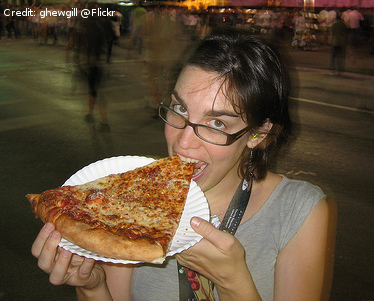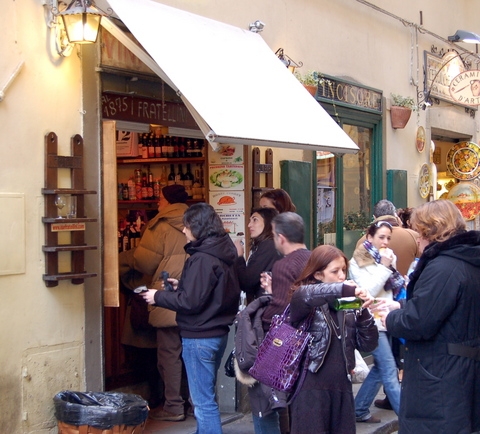Although I’ve learned to never say never – Italians never eat while they’re walking or standing. They have no culture of snacking on the types of food that Americans are frequently noshing on as they hurry from place to place – no Big Gulps, Grande Lattes with extra foam, bags of Cool Ranch Doritos, Walking Tacos, Big Macs, or even, a panino con mortadella. (Yes, there are Big Macs in Italy, but they are being eaten – slowly – while at the table provided, not on the run.)

This aversion to eating and drinking while walking (“Che schifo!” says Florentine Francesca) is ingrained from a young age, perhaps by a mother who values spotless clothes on her off-spring. More likely, by a mother who wants her family at the table on time and hungry, not missing in action or stuffed with chips before the meal even begins.

But more to the point, eating is still very closely linked to the national heritage of consuming good food for pleasure. Even in today’s busy world, over 70 per cent of Italians eat meals they have prepared at home; the favorite place to eat both lunch and dinner is in the home, with almost 70 per cent eating at the family table. In the U.S., by contrast, we eat our meals (a) standing up in our kitchens, (b) in front of Jersey Shore, CSI or the PBS NewsHour, (c) at our desk while catching up on emails, (d) in our cars, or (e) walking down a city block between appointments.

Whereas the Italians wish to spend up to two hours over lunch, we bolt down our food in the time it would take them to savor a crostino spread with duck liver. The Italian secret to avoiding obesity is to sit down with friends or family for a meal, and to eat three times a day at regular intervals; eating slowly, enjoying both the food and the company.
In Italy, a meal is a very particular moment, in which you share pleasure, the food as well as the conversation. From an American point of view, food is usually just fuel to give energy and drink is to add the caffeinated turbo-charge.
Of course, Italian food is real food – prepared in the kitchen, with time taken to choose, buy and prepare meals. In other words, there is space for food in the daily routine. Eating in Italy is a social activity. There are several courses, but they are small with plenty of time between dishes for the physiological feedback to kick in as the brain tells the stomach enough is enough.

Even when Italians are forced to stand while eating, like at my favorite panino place, I Due Fratellini, a small hole in the wall (literally) where the best sandwiches in Florence are made, it is done with style. There are two sets of numbered shelves so you can set your glass of wine down as you take the six bites that will finish the minimalist panino made with a maximum of three of the finest ingredients inside a warm crunchy bread roll.

So what about gelato? Yes, it is an exception to the Italian Food Rule – No eating while walking. Italians walk while licking a small (2.50 € or less) cone – a cone, not a cup – of gelato. If you order a medium or large cone you are not Italian. If you are eating gelato out of a cup, you should be sitting in the gelateria or on a nearby bench. It’s complicated.
In conclusion, while Americans are speed-eating, gulping down a 550 calorie lunch solely consisting of a Starbucks Venti Dulce de Leche Blended Creme Frappuccino (“Che esagerazione!” says Francesca) before the light turns green and it’s okay to cross, the Italians are taking small mouthfuls, resting their cutlery between bites, discussing the food – because it is worthy of discussion.
